Great Danes are beautiful and majestic dogs that can look quite intimidating but are friendly and dependable creatures. They are known for their strong gait, muscular and long necks and height.
If you want to bring a Great Dane home as a pet, there are various types of Great Danes out there with coats of distinct colors and patterns. However, if you want your Great Dane to compete officially as a show dog, there are certain criteria that they should meet.
There are 7 officially recognized Great Dane colors that you should be familiar with if you want your pooch to participate in a dog show. These colors are fawn, merle, brindle, blue, black, harlequin and mantle. The following sections will take you through those colors in some more detail.
Fawn
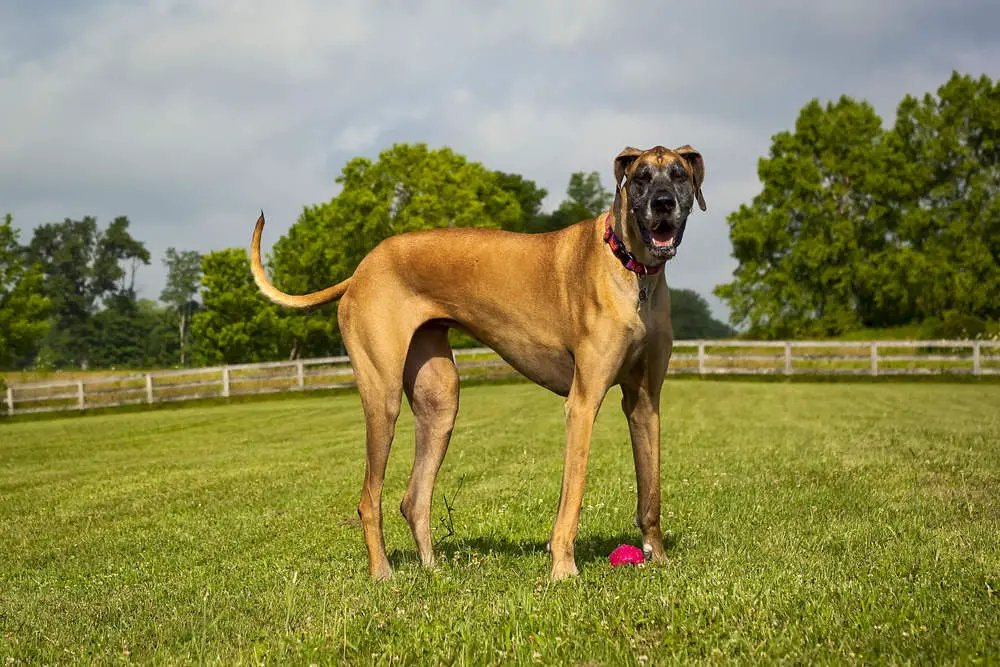
Fawn is one of the most common colors one may think of when trying to picture a Great Dane. Perhaps this is because one of the most famous Great Danes, Scooby-Doo, is of this brilliant fawn color. According to the American Kennel Club, the desired shade of fawn on a Great Dane should be yellow gold, preferably a deeper yellow gold.
One of the attributes of the officially recognized fawn Great Dane is that it should have black patterns and markings on its eye rims and eyebrows. The black markings may even appear on the ears and the tip of the tail as well. The AKC has also explicitly stated that white markings on the chest and toe are not desirable and does not qualify as an official entry to a competition. The deep yellow gold of the coat should also be “clean” and should not have any speck of black or white.
Will a Blue-Fawn Great Dane Qualify?
A Blue-Fawn Great Dane is a predominantly fawn Great Dane with blue markings where the black should be. While the hue of blue is deep enough that it can be passed off as black, a Blue-Fawn Great Dane is not taken to be the breed standard. These are great looking dogs, but this is not an officially recognized color.
Merle
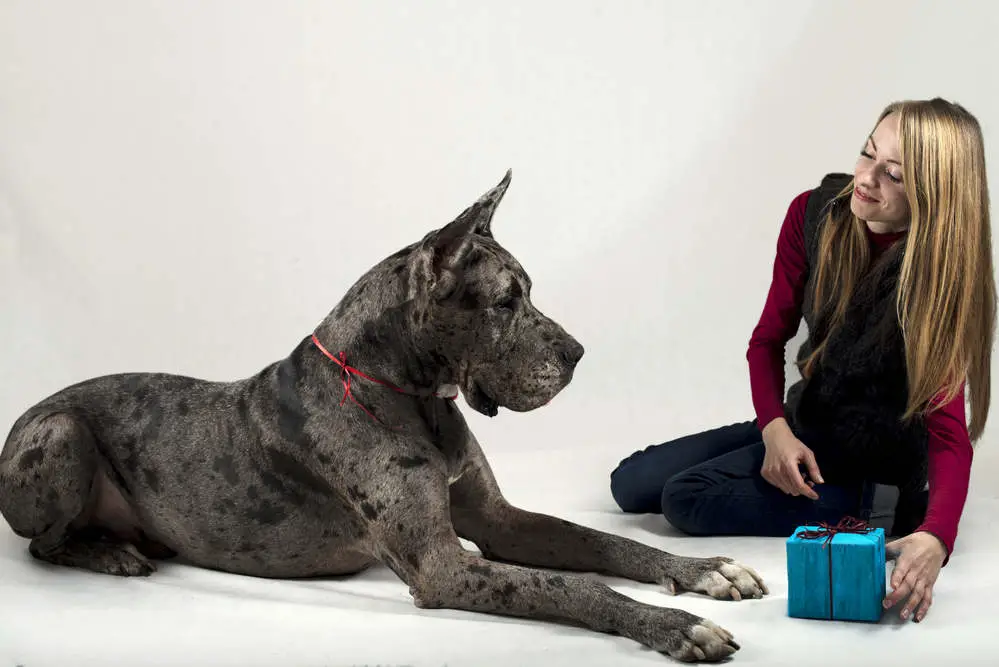
Merle Great Danes have a pale to dark grey colored base coat, with dark splotches of black within the coat. There are a few different variations the AKC and other organizations permit in a merle Great Dane. It can be a solid merle with white markings on the chest and toes or it can be a merle with mantle pattern, which means a solid merle coat that extends all over the body with a white muzzle, blaze and whole or partial white neck and chest.
The dog may also have white patches on the legs as well as the tip of the tail. What is not permitted, however, is for a white dog to only have patches of merle, also known as a merlequin Great Dane.
What Is the Merle Gene?
Merle, as has been described above, is a coat pattern where there are random spots of a darker pigment of the same color as the base coat. This distinct coat pattern is a result of genetics. For the merle coat pattern to appear, the parent Great Dane must carry a single strain of the “M allele” genotype. While all non-merle dogs carry the genotype “mm”, all merle dogs have “Mm”.
While the merle gene is certainly one that gives the Great Dane a distinct and wonderful look, getting two merle parents to breed will not give you the desired merle pattern. The offspring in this litter are more likely to be solid white with only a few merle patches—something the AKC does not recognize as an official color. Besides, double-merle dogs are also prone to various kinds of health complications such as sight and vision problems.
Brindle
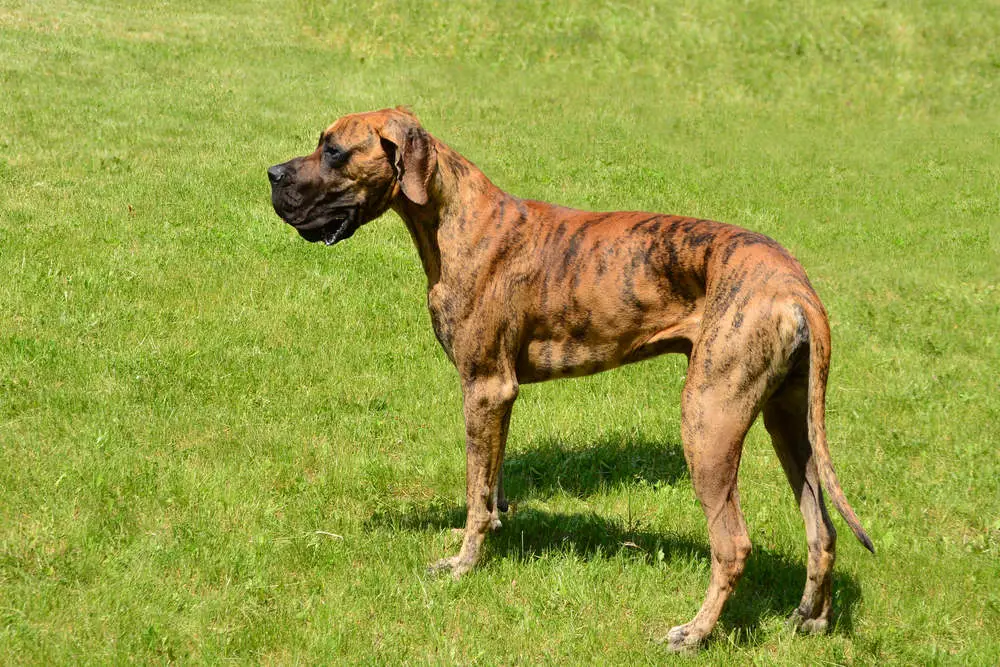
Brindle Great Danes have a yellow gold coat with strong tiger-like stripes in black. The AKC specifications say that the Brindle Great Danes can have a black chevron pattern and a prominent black mask. The black markings should certainly also appear on the eye rims and eyebrows and may appear on the ears and the tip of the tail.
The deeper the base color and the more distinctly and evenly brindled the stripes, the more preferred the color will be as an officially recognized type. The organization also specifies that too much brindling or too little brindling will also not be desirable, neither are white marks on the chest and toes.
Blue
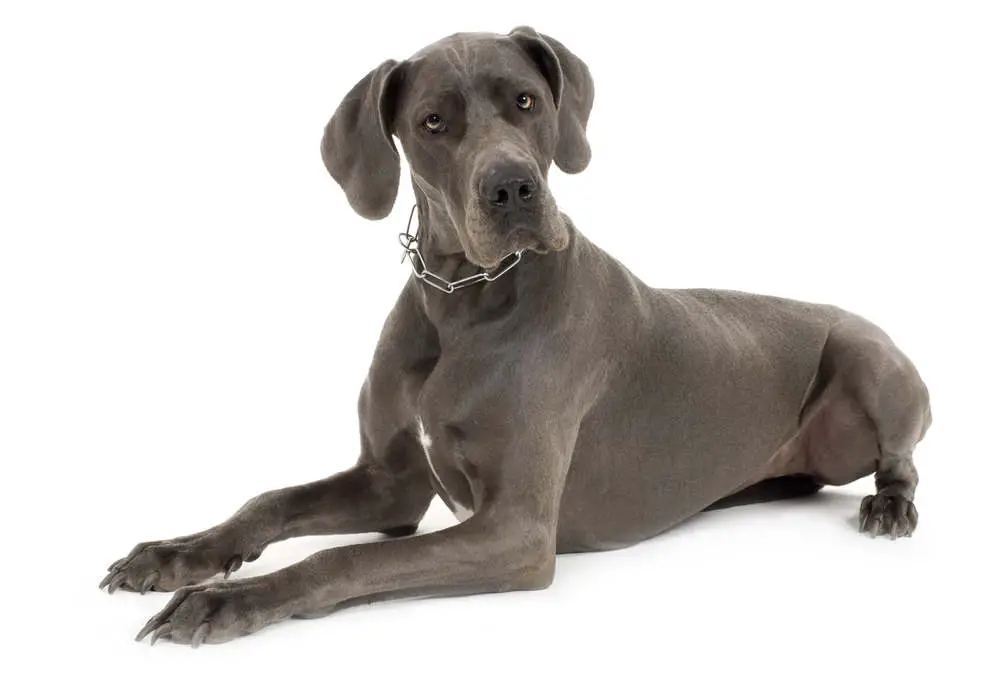
Blue Great Danes have a striking steel blue colored coat. For it to be recognized as an official color, the coat should be of a solid hue and white markings on the chest or the toes are not desirable. Blue Great Danes can have coats of various shades, from pure steel blue to slate, charcoal, pale grey, etc. But the steel blue is the most desirable shade and the one recognized by AKC and other organizations if you want your Blue Great Dane to compete as a show dog. Blue Great Danes can have dark brown, amber or even blue eyes.
A note of caution, however, when it comes to the blue-eyed Great Danes. In some cases, this eye color could also be a result of a merle gene in the breeding as pale blue eyes are most commonly seen among blue merle Great Danes. A pure blue Great Dane is one where both parents have the recessive blue gene.
Black
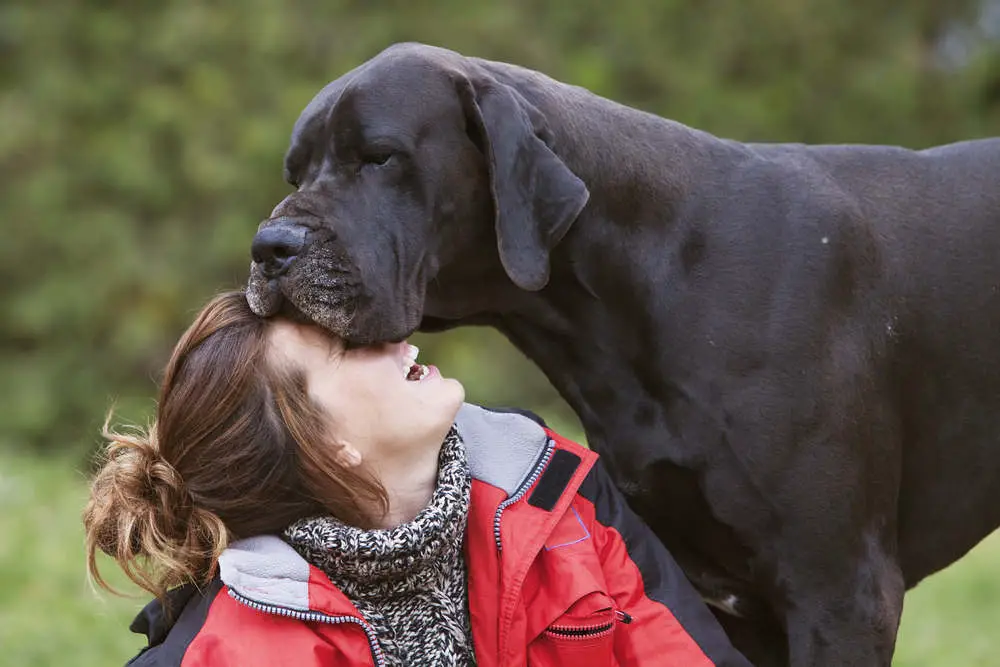
A black Great Dane should have a glossy black coat for it to qualify as a show dog. The coat of this type of Great Dane should be a solid black and markings of white or any other color are not desirable. A pure Black Great Dane is produced only as a result of breeding two black Great Danes. It is common for black Great Danes to have some color variations or spots on their coat, but note that the AKC does not recognize these variations as markings of a true black Great Dane.
Zeus, the world’s tallest dog, was also a black Great Dane.
Harlequin
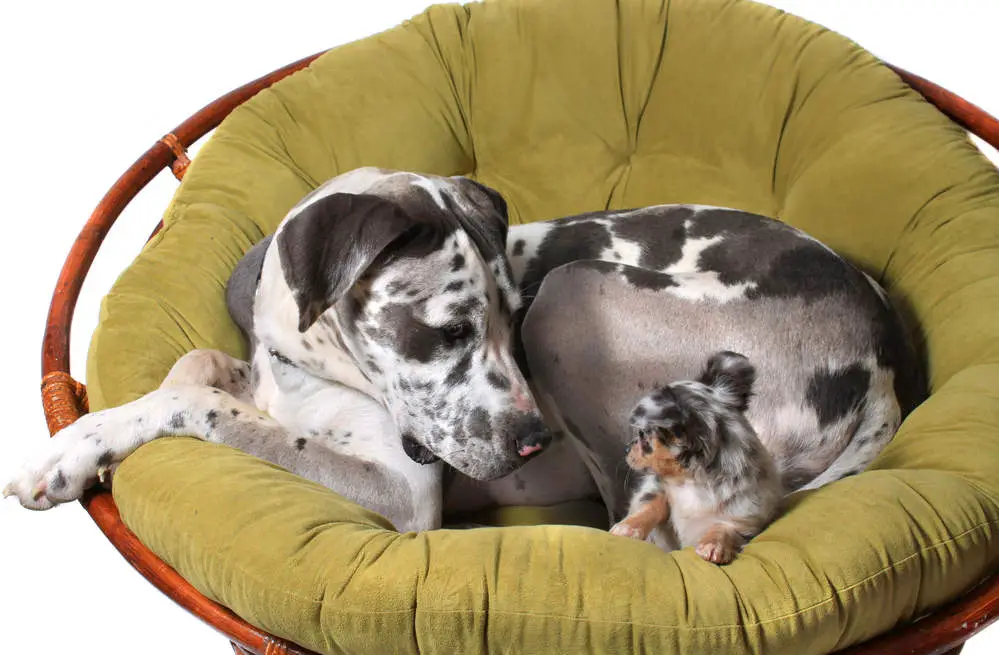
Harlequin Great Danes have a solid white base coat with black torn patches. The patches can be distributed all along the body, however, no patch should be so large that it seems like a blanket. These dogs tend to have a whole or partial white neck and one may also see black pigments on the skin in predominantly white areas.
Harlequin Great Danes may also have tufts of black hair peeking through the white base coat which gives it a salt and pepper look or a “dirty” look. While such Great Danes will be eligible to participate in official competitions according to the AKC specifications, this is a less desirable physical attribute.
Harlequin vs Merle: What’s the Difference?
It is easy to confuse Harlequin Great Danes with Merle Great Danes when you just read the physical description. However, a big difference between the two is that Harlequins usually have a white base coat with black spots, whereas merles have a grey base coat, with dark grey or black spots. A merlequin coat, on the other hand, will have a white base coat and patches of merle which is not recognized by the AKC as an official color. Merles can often be produced from Harlequin litters, but the reverse is not true.
Mantle
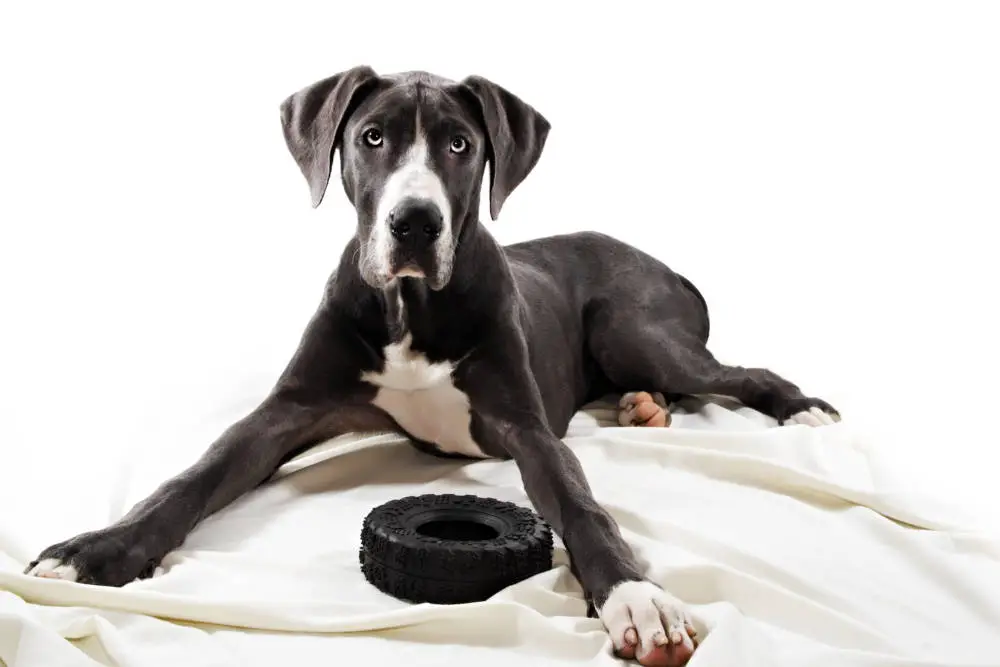
Mantle Great Danes have a black blanket covering the body, with a white chest, muzzle and whole or part of the legs. The tip of the tail in Mantle Great Danes may also be white, while a white blaze is also optional. One may also find black pigment on the skin in the predominantly white areas. They have very similar markings to a Boston Terrier. In fact, until the 1990s they were considered to fall under the same Boston Terrier breed and were not identified as a separate breed.
The only mantle Great Danes that can qualify as show dogs are the ones that have a pure black and white coat, with no markings of any other color like fawn, brown, merle, etc.
General Appearance
Apart from the officially recognized colors, there are some other specifications that the AKC has listed out when it comes to the general appearance of Great Danes that can qualify as show dogs. The Great Dane should have a “smoothly muscled body” and should have a courageous and dependable personality. The distinct feature of a true Great Dane is an excellent combination of physical as well as mental sharpness.
Size and Proportion
The male Great Danes tend to be larger than the females in terms of the as well as bone weight. In a length and height ratio, Great Danes tend to be square, though females can have a slightly longer body (provided it is proportional to the height).
The males should not be less than 30 inches at the shoulders (though it is preferred if they are above 32 inches but not disproportionate to their height). Meanwhile, females should not be less than 28 inches at the shoulder (though it is preferred if they are above 30 inches but not disproportionate to their height).
Related: How Big Do Great Danes Get?
Neck
Whether male or female, the neck should be long, muscular, high set and well arched. The nape of the neck should gradually broaden and extend into the withers, forming a smooth curve. The neck underline should be distinct and clean. The long and muscular neck is one of the defining traits of a true Great Dane.
Body and Topline
The withers of the dog should extend down smoothly to the back and a broad loin area. It is also important that the chest of the Great Dane be broad and muscular, whether male or female. Most importantly, the tail should be high but not at the same level as the back. When resting, the tail should fall straight. When the Great Dane is excited the tail may curve slightly, but it should never rise above the level of the back. A docked tail is not permitted by AKC.
Head
The head of the Great Dane is also an important physical characteristic to look at if you want them to officially compete. The head should be long, rectangular and muscular (“finely chiseled, especially below the eyes”, to quote AKC). In the side profile, the Great Dane’s forehead should be distinct from the bridge of its nose at a sharp angle. The plane of the skull and the muzzle should parallel to one another and should not curve. The structural jaw and head are what determines the pronounced masculinity of the male, while the female Great Danes may have more delicately formed heads.
The eyes of the Great Dane are typically medium sized and they should be deep set and dark. As mentioned above, some harlequin and merle dogs may have blue eyes. This is permitted as long as it is a darker shade of blue. Eyes of different colors are also permitted. In the case of harlequins and merles, a spotted nose is also permitted but in all other cases, the nose should be black (except among blue Great Danes, where the nose is blue-black). A pink nose is not desirable in any case.
The ears, whether cropped or not, should be set high and should be of medium thickness.
Also Read: Are Great Danes Good Swimmers?
The Final Word
Everyone thinks their pet is the best looking and could win a prize in a competitive event. But while people are justified in thinking that about their beloved pets, there are certain regulations in place that make it possible to create a standard within which a variety of dogs may be able to compete.
The specifications laid out by AKC are so that there are no ambiguities about what kinds of dogs can compete. These criteria are also strict and each dog must undergo several levels of tests to be able to qualify as a show dog. The specifications about color and general appearance described above are taken to be the standard in most of North America and may even be the case in parts of Europe.
